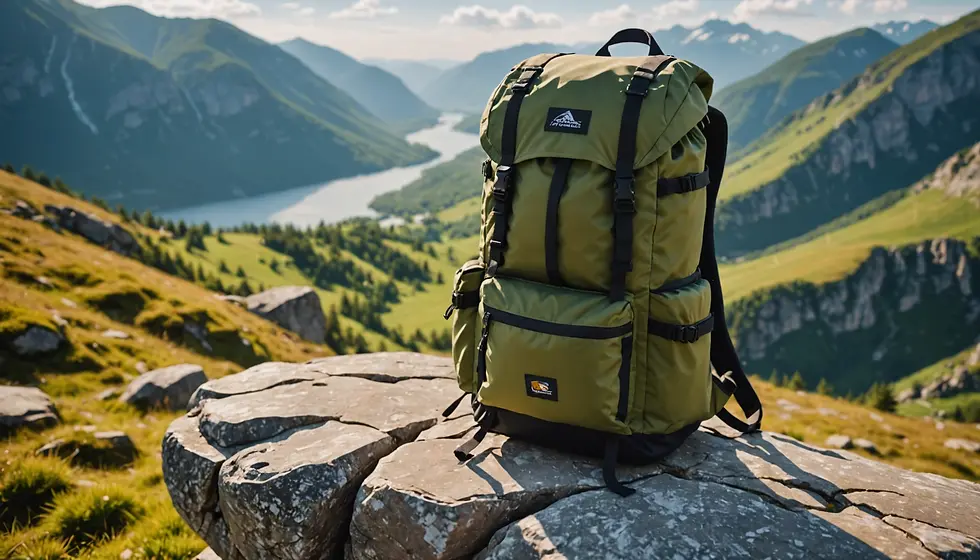Solo Backpacking Gear Guide: Essentials for the Trail
- Jason

- Feb 17
- 4 min read
Updated: Dec 1

Introduction
Each category is designed to enhance safety, preparedness, and adaptability in the wilderness. This checklist helps backpackers ensure they have the right equipment for different conditions while maintaining a balance between necessity and pack weight.

How to Use This Guide
Test Your Gear: Familiarize yourself with your equipment before heading out. Ensure everything functions properly, and understand how to use each piece.
Understand Your Limits: Choose gear that matches your skill level, physical endurance, and the specific challenges of your trip.
Respect Nature: Follow Leave No Trace principles, properly store food, and minimize your environmental impact.
Local Regulations: Always check local rules for food storage, permits, fire restrictions, and camping policies.
Pack Weight & Volume: Keep your load manageable. If traveling ultra-light, prioritize multi-use items and reduce redundancy.
Skills Over Gear: Having the right equipment is important, but knowledge of navigation, first aid, and survival techniques is equally critical.
Disclaimer
Backpacking carries inherent risks, and this guide is intended as an aid for planning rather than a definitive survival manual. Each individual is responsible for their own safety, preparation, and decisions in the wilderness. Always research your route, assess your fitness, and consider professional guidance when necessary.
The Backpacker’s Ten: Comprehensive Gear Checklist

1. Mindset & Strategy
□ Trip plan (Shared with a trusted contact)
□ Emergency contacts & protocols (Know local emergency numbers, weather updates)
□ Basic Leave No Trace (LNT) knowledge (Minimize impact, follow ethical travel practices)
□ Small amount of emergency cash & photo ID
□ Backcountry permit or reservation (if required)
□ Forest Service/park pass (if required)
2. Shelter & Insulation (Protection from exposure)

□ Primary Shelter (Backpacking tent or hammock system)
□ Lightweight tarp (Emergency shelter or additional protection)
□ Sleeping bag (Rated for expected temperatures)
□ Sleeping pad (For insulation and comfort)
□ Rain jacket or hardshell
□ Insulated jacket (Down or synthetic)
□ Base layers (For warmth and moisture management)
□ Hiking pants or shorts (Appropriate for conditions)
□ Hiking boots or shoes (Properly broken in)
□ Hiking socks (Wool or synthetic; bring extra pairs)
□ Gloves (Insulated for cold, work gloves for rugged terrain) (Cold-Weather)
□ Beanie (Cold-Weather)
□ Neck gaiter or balaclava (Cold-Weather)
□ Tent footprint or ground cloth (If needed)
□ Extra stakes & guylines
□ Sleeping bag liner (Optional: Adds warmth & keeps bag cleaner)
□ Additional ground insulation (Closed-cell foam pad for extreme cold) (Cold-Weather)
□ Camp shoes (Lightweight for comfort at camp)
3. Water & Purification (Safe hydration)
□ Primary water filter or purifier (GRAYL, Sawyer Squeeze, etc.)
□ Hydration bladder / water bottles (2L minimum capacity)
□ Backup water purification tablets or drops
□ Lightweight cooking pot (For boiling water as last resort)
4. Fire & Light (Ignition & illumination)
□ Primary fire starter (Lighter & waterproof matches)
□ Backup ignition (Ferro rod or stormproof matches)
□ Tinder/fire starter (Fatwood, cotton balls with Vaseline, etc.)
□ Headlamp or flashlight (With extra batteries or rechargeable power source)
5. Tools & Repairs (Essential gear maintenance)
Cutting Tools
□ Fixed-blade knife or folding knife
□ Folding saw (Optional for wood processing)
Cordage & Knots
□ Paracord or bank line (50 ft minimum)
□ Carabiners (For rigging shelters, hanging gear, etc.)
Gear Repair & Maintenance
□ Basic repair kit (Zip ties, wire, Tenacious Tape, extra buckles/webbing, multi-purpose glue)
□ Sewing kit (For gear repairs)
□ Duct tape (Wrapped around trekking pole or bottle for emergency repairs)
6. Food & Fuel (Caloric needs & cooking)

□ Backpacking stove & fuel
□ Lightweight cookware (Pot, cup/mug, spork/long spoon)
□ Backpacking food (Freeze-dried meals, energy bars, high-calorie snacks)
□ Bear-proof food storage (Bear bag + hanging system, Ursack, or bear canister if required)
□ Electrolytes & energy supplements (Tablets, powder, or gels)
□ Instant coffee or tea bags (Optional for morale boost)

7. Navigation & Orientation (Staying on course)
□ Map & compass (Always carry these, even with GPS)
□ GPS device or phone with offline maps (Ensure key waypoints are preloaded & tested)
□ Notebook & pen/pencil (For recording bearings, landmarks, and travel logs)
□ Whistle (For emergency signaling & wildlife deterrence)
□ Locate on map: water sources, potential campsites, emergency exits
8. First Aid & Hygiene (Injury prevention & cleanliness)

□ First-aid kit (Bandages, wound closure strips, antiseptic, pain relievers, tweezers, etc.)
□ Personal medications
□ Moleskin or blister treatment
□ Hygiene essentials (Toothbrush, biodegradable soap, wipes, hand sanitizer, etc.)
□ Quick-drying towel
□ Trowel & toilet kit (Wag Bags for high-impact areas)
□ Sunscreen & sunglasses (Sun protection is essential year-round)
□ Camp shoes (Airing out feet prevents blisters & trench foot)
9. Communication & Signaling (Emergency readiness)
□ Fully charged phone & backup power bank
□ Satellite messenger or emergency beacon (Garmin inReach, SPOT, etc.)
□ Weather radio (Optional, but useful for remote locations)
□ Signal mirror or light stick (For emergency signaling)
10. Loadout & Gear Security (Organization & protection)
□ Pack rain cover (If not included in backpack design)
□ Ziplock bags/dry bags (For organizing & waterproofing gear)
□ Backpacking chair or sit pad (Optional but highly recommended for comfort & insulation)
□ Multi-purpose cloth (Bandana or shemagh: Useful for filtering water, head protection, first aid, cleaning, or emergency sling)
□ Trekking poles (Optional but highly recommended for stability & knee relief)
□ Daypack (For side hikes or carrying essentials from basecamp)
□ Notebook or journal (Optional for reflections, navigation logs, or field notes)
□ Camera (Optional but nice for capturing memories)
□ Book or Kindle (Optional for downtime at camp)
Want a simple system for safer, smarter trips?
Take my online course, The Backpacker’s Ten: Strategic Wilderness Foundations.




Comments